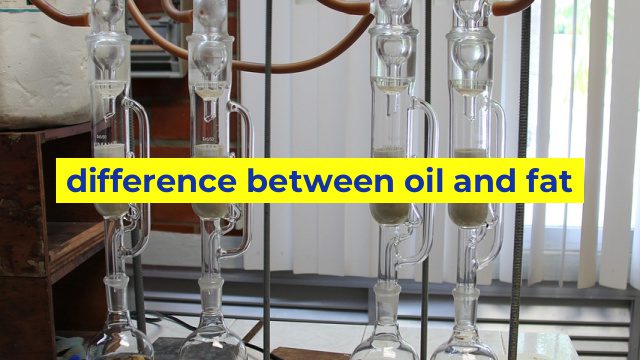The Difference Between Oil and Fat
When it comes to cooking and diet, oil and fat are often used interchangeably. However, they are not the same thing. Both oil and fat are essential in cooking, but their properties and effects on health differ greatly. In this article, we will explore the differences between oil and fat.
Chemical Composition
The main difference between oil and fat is their chemical composition. Oil is a liquid at room temperature and is made up of unsaturated fats, which are liquid at room temperature. On the other hand, fat is solid at room temperature and is made up of saturated fats, which are solid at room temperature.
Health Benefits and Risks
Since oil and fat have different chemical compositions, they also have different effects on health. Unsaturated fats in oil are considered to be healthier than saturated fats in fat. This is because unsaturated fats can improve cholesterol levels, reduce inflammation, and lower the risk of heart disease. On the other hand, saturated fats can raise cholesterol levels, increase inflammation, and lead to heart disease.
However, not all oils are equal. Some oils, such as coconut oil, are high in saturated fats and therefore not as healthy as other oils like olive oil, which is high in monounsaturated fats. It is important to choose oils that are high in healthy fats and avoid those that are high in unhealthy fats.
Cooking Properties
Oil and fat also have different cooking properties. Since oil is a liquid, it is ideal for cooking at high temperatures because it doesn’t burn easily. Fat, on the other hand, has a lower smoking point and can burn easily when heated at high temperatures. This makes oil better for frying, while fat is better for baking.
Conclusion
In summary, oil and fat are not the same thing. Oil is a liquid at room temperature and is made up of unsaturated fats, while fat is solid at room temperature and is made up of saturated fats. They have different effects on health, cooking properties, and should be used judiciously in cooking and diet. Choosing oils that are high in healthy fats and avoiding those that are high in unhealthy fats is important for maintaining a healthy diet.
Table difference between oil and fat
| Oil | Fat | |
|---|---|---|
| Definition | A liquid that comes from plants, animals, or minerals. | A solid or semi-solid substance that comes from animals or plants. |
| Source | Plants, animals, or minerals. | Animals or plants. |
| Types | Varieties include vegetable, nut, and fish oils. | Varieties include butter, lard, and margarine. |
| Form | Usually liquid at room temperature, but can also be solid or semi-solid. | Usually solid at room temperature, but can also be liquid. |
| Uses | Used for cooking, baking, frying, and as a flavoring agent or salad dressing. | Used for cooking, baking, frying, as a spread, and in the production of processed foods and snacks. |
| Nutritional value | Provides both essential and non-essential fatty acids, and can be a good source of vitamins and minerals. | High in calories and can contribute to obesity and other health problems if consumed in excess. |
